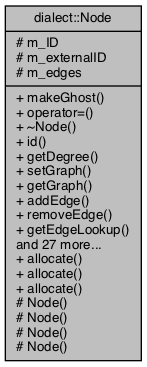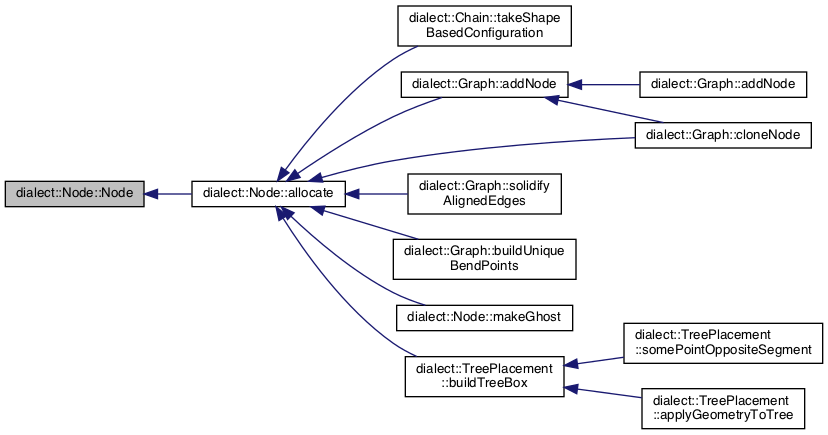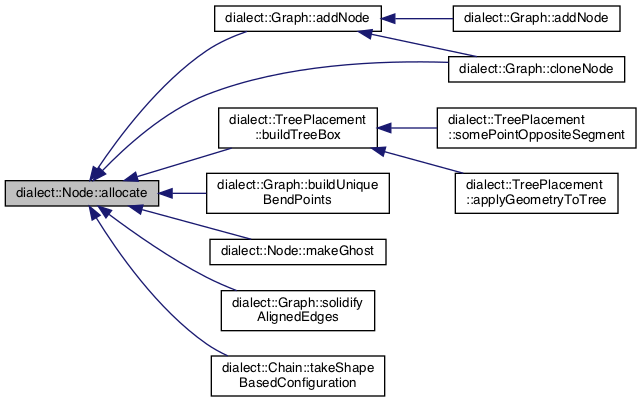The Node class represents nodes in a graph. More...
#include <graphs.h>


Public Member Functions | |
| GhostNode_SP | makeGhost (void) const |
| Allocate a GhostNode of this Node. | |
| dialect::Node & | operator= (const dialect::Node &)=default |
| Copy-assignment operator. | |
| virtual | ~Node (void)=default |
| Destructor. | |
| virtual id_type | id (void) const |
| Access the unique ID of a given instance. More... | |
| unsigned | getDegree (void) const |
| Check the degree (number of incident Edges) of the Node. More... | |
| void | setGraph (Graph &graph) |
| Tell the Node which Graph it belongs to. More... | |
| Graph * | getGraph (void) |
| Access the Graph to which the Node belongs. | |
| void | addEdge (const Edge_SP &edge) |
| Add an incident Edge. | |
| void | removeEdge (const dialect::Edge &edge) |
| Remove an incident Edge. | |
| const EdgesById & | getEdgeLookup (void) const |
| Read-only access to this Node's lookup map for Edges by their ID. | |
| EdgesById | getCopyOfEdgeLookup (void) const |
| Get a copy of this Node's lookup map for Edges by their ID. | |
| void | copyGeometry (const dialect::Node &other) |
| Give this Node the same coordinates and dimensions as another. | |
| void | copyOtherGhostProperties (const dialect::Node &other) |
| Besides copying geometry, there may be other properties we wish to copy; in particular, properties that are suitable to be copied by a GhostNode. | |
| dimensions | getHalfDimensions (void) const |
| Get an ordered pair (half-width, half-height) for this Node. | |
| dimensions | getDimensions (void) const |
| Get an ordered pair (width, height) for this Node. | |
| BoundingBox | getBoundingBox (void) const |
| Get the bounding box for this Node. | |
| Avoid::Point | getBoundaryCompassPt (CompassDir dir) const |
| Get the point on the boundary of this Node in a given direction from its centre. | |
| void | setCentre (double cx, double cy) |
| Set the position of the node, by setting its centre coordinates. | |
| void | translate (double dx, double dy) |
| Update the position of the node, by adding to its centre coordinates. | |
| void | applyPlaneMap (PlaneMap map) |
| Apply a mapping from libavoid Points to libavoid Points, to this Node's centre. | |
| Avoid::Point | getCentre (void) const |
| Get the centre coordinates of the node. | |
| void | setExternalId (unsigned id) |
| Set an externally-determined ID. (This is useful for TGLF and other interfacing operations.) | |
| int | getExternalId (void) |
| Get the external ID. | |
| dialect::Nodes | getNeighbours (void) const |
| Get the neighbours of this Node. | |
| dialect::Nodes | getNeighboursCwCyclic (void) const |
| Get the neighbours of this Node, listed in clockwise cyclic order (assuming the usual graphics convention of x increasing to the right and y increasing downward). | |
| virtual dialect::Nodes | getChildren (void) const |
| Get the neighbours of this Node that sit as the target end of the connecting Edge. More... | |
| void | setDims (double w, double h) |
| Set the dimensions of the node. | |
| void | setBoundingBox (double x, double X, double y, double Y) |
| Set the bounding box of the node. This sets both the dimensions and the centre point. More... | |
| void | addPadding (double dw, double dh) |
| Add padding to the node's dimensions. More... | |
| void | updatePosnFromRect (vpsc::Rectangle *r) |
| Update the position of this Node to equal that of the given Rectangle. | |
| void | updateXCoordFromRect (vpsc::Rectangle *r) |
| Update the x-coordinate of this Node to equal that of the given Rectangle. | |
| void | updateYCoordFromRect (vpsc::Rectangle *r) |
| Update the y-coordinate of this Node to equal that of the given Rectangle. | |
| Avoid::Polygon | makeLibavoidPolygon (void) const |
| Build and return a Polygon to represent this Node in libavoid. | |
| bool | isRoot (void) const |
| Check whether this Node has been marked as being a root. This is useful when working with trees, and can be safely ignored when working with other sorts of graphs. | |
| void | setIsRoot (bool isRoot) |
| Say whether this Node is a root. This is useful when working with trees, and can be safely ignored when working with other sorts of graphs. | |
| bool | liesOppositeSegment (const LineSegment &seg, bool openInterval=false) |
| Check whether this Node lies opposite a LineSegment, i.e. whether the sides of the Node lying parallel to the segment intersect its interval. More... | |
| std::string | writeSvg (bool useExternalId=false) const |
| Write SVG to represent this Node. More... | |
Static Public Member Functions | |
| static Node_SP | allocate (void) |
| Factory function, to get a shared pointer to a Node allocated on the heap. We make the constructors protected, in order to ensure that Nodes always come with a control block. More... | |
| static Node_SP | allocate (double w, double h) |
| Convenience factory function to set dimensions. | |
| static Node_SP | allocate (double cx, double dy, double w, double h) |
| Convenience factory function to set position and dimensions. | |
Protected Member Functions | |
| Node (void) | |
| Default constructor. More... | |
| Node (double w, double h) | |
| Construct with dimensions. | |
| Node (double cx, double cy, double w, double h) | |
| Construct with position and dimensions. | |
| Node (const dialect::Node &)=default | |
| Copy constructor. | |
Protected Attributes | |
| const id_type | m_ID |
| An instance's own unique ID: | |
| int | m_externalID = -1 |
| EdgesById | m_edges |
| Lookup table for incident Edges by Edge's ID: | |
Detailed Description
The Node class represents nodes in a graph.
Constructor & Destructor Documentation
◆ Node()
|
inlineprotected |
Default constructor.
Each Node has an ID number, unique among Nodes (but not necessarily distinct from ID numbers of objects of other classes).
Referenced by allocate().

Member Function Documentation
◆ addPadding()
| void Node::addPadding | ( | double | dw, |
| double | dh | ||
| ) |
Add padding to the node's dimensions.
- Note
- Amounts can be positive or negative, thus adding or subtracting padding.
◆ allocate()
|
static |
Factory function, to get a shared pointer to a Node allocated on the heap. We make the constructors protected, in order to ensure that Nodes always come with a control block.
- Returns
- A shared_ptr to Node (Node_SP).
References Node().
Referenced by dialect::Graph::addNode(), dialect::TreePlacement::buildTreeBox(), dialect::Graph::buildUniqueBendPoints(), dialect::Graph::cloneNode(), makeGhost(), dialect::Graph::solidifyAlignedEdges(), and dialect::Chain::takeShapeBasedConfiguration().


◆ getChildren()
|
virtual |
◆ getDegree()
|
inline |
◆ id()
|
inlinevirtual |
Access the unique ID of a given instance.
- Returns
- The ID.
Reimplemented in dialect::GhostNode.
References m_ID.
Referenced by dialect::Edge::getOtherEnd(), dialect::Graph::removeNode(), and setExternalId().

◆ liesOppositeSegment()
| bool Node::liesOppositeSegment | ( | const LineSegment & | seg, |
| bool | openInterval = false |
||
| ) |
Check whether this Node lies opposite a LineSegment, i.e. whether the sides of the Node lying parallel to the segment intersect its interval.
- Parameters
-
seg The LineSegment in question. openInterval Boolean saying whether we should treat the interval in question as an open one (i.e. not including its endpoints). Defaults to false, so that the closed interval is considered by default.
References getBoundingBox(), and vpsc::XDIM.

◆ setBoundingBox()
| void Node::setBoundingBox | ( | double | x, |
| double | X, | ||
| double | y, | ||
| double | Y | ||
| ) |
Set the bounding box of the node. This sets both the dimensions and the centre point.
- Parameters
-
[in] x The minimum x-coord of the box. [in] X The maximum x-coord of the box. [in] y The minimum y-coord of the box. [in] Y The maximum y-coord of the box.
◆ setGraph()
|
inline |
◆ writeSvg()
| string Node::writeSvg | ( | bool | useExternalId = false | ) | const |
Write SVG to represent this Node.
- Parameters
-
[in] useExternalId If true, write external ID as label; otherwise write internal unique ID.
- Returns
- A string containing the SVG.
References getBoundingBox(), dialect::BoundingBox::h(), m_externalID, m_ID, dialect::string_format(), and dialect::BoundingBox::w().

Member Data Documentation
◆ m_externalID
|
protected |
A Node can store an ID specified externally, as by TGLF. Although external IDs are restricted to non-negative integers, we store the ID as an integer, so that we can use a negative value to indicate that none has been set.
Referenced by getExternalId(), setExternalId(), and writeSvg().
The documentation for this class was generated from the following files:
- libdialect/graphs.h
- libdialect/graphs.cpp
- libdialect/nodes.cpp
 1.8.14
1.8.14